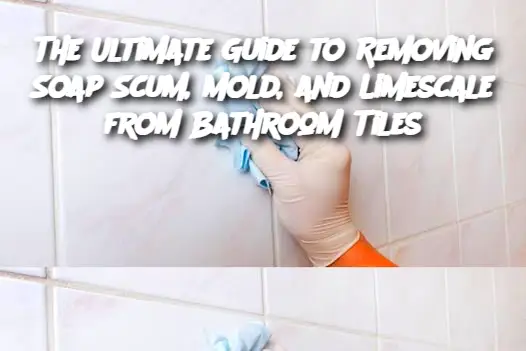Introduction
Bathrooms are prone to grime, soap scum, mold, and limescale buildup due to constant moisture and humidity. Over time, these stubborn stains can make your bathroom tiles look dull and unappealing. Fortunately, you don’t need to resort to expensive cleaning products to restore the shine and cleanliness of your bathroom tiles. With a few simple, effective techniques and common household ingredients, you can easily remove soap scum, mold, and limescale, leaving your tiles sparkling clean. This article will walk you through the best tricks to combat these issues, giving you a fresh and hygienic bathroom in no time.
Ingredients:
White vinegar
Baking soda
Dish soap (preferably a degreaser type)
Hydrogen peroxide (optional for mold)
Water
A spray bottle
An old toothbrush or soft-bristled brush
Microfiber cloth or sponge
Rubber gloves (for protection)
Instructions:
Remove Soap Scum:
Step 1: Start by filling a spray bottle with equal parts of white vinegar and water.
Step 2: Shake the bottle to mix the solution, then spray it generously on the areas affected by soap scum.
Step 3: Allow the vinegar solution to sit for 10-15 minutes to break down the soap scum.
Step 4: After the waiting period, use a microfiber cloth or sponge to wipe the area. For stubborn spots, use an old toothbrush to gently scrub away the soap scum.
Step 5: Rinse with warm water to remove any residue.
Combat Mold and Mildew:
Step 1: Mix a solution of 1 part hydrogen peroxide to 2 parts water in a spray bottle.
Step 2: Spray the moldy or mildew-infested areas with the hydrogen peroxide solution and let it sit for about 15-20 minutes.
Step 3: After the solution has had time to work, scrub the affected area with a soft-bristled brush or an old toothbrush.
Step 4: Wipe the area with a damp cloth to remove any remaining mold spores, and then rinse thoroughly with water.
Remove Limescale:
Step 1: Apply white vinegar directly to the limescale buildup. You can use a cloth or sponge soaked in vinegar to target hard-to-reach areas.
Step 2: Let the vinegar sit on the limescale for 15-20 minutes to break down the mineral deposits.
Step 3: Sprinkle baking soda on the area and use a damp cloth or sponge to scrub in a circular motion. The abrasive nature of baking soda helps remove stubborn limescale without damaging the tiles.
Step 4: After scrubbing, rinse the area thoroughly with warm water to wash away any residue.
For Severe Cases: If you have heavy buildup of soap scum, mold, or limescale that doesn’t come off with the basic methods, you can repeat the process, or consider using a commercial cleaner specifically designed for the issue. However, always check if the cleaner is safe for your tiles and follow the manufacturer’s instructions.
Tips for Serving and Storing:
Prevention: To minimize future buildup of soap scum, mold, and limescale, make sure to dry the tiles and grout after every shower. You can use a microfiber cloth or a squeegee to remove excess water. This will help reduce the chances of grime accumulating.
the rest on next page
ADVERTISEMENT

